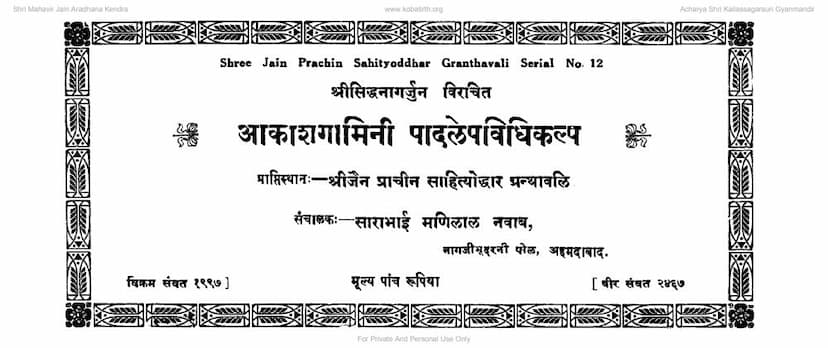Akashgamini Padlepvidhi Kalpa
Added to library: September 1, 2025

Summary
This Jain text, "Akashgamini Padlepvidhi Kalpa" (आकाशगामिनी पादलेपविधी कल्प), authored by Siddha Nagarjun (सिद्ध नागार्जुन) and published by Jain Prachin Sahityoddhar Granthawali, is a treatise on various medicinal and mystical preparations, primarily focusing on achieving specific outcomes through the application (lepa) of herbal and mineral substances. The title itself, "Akashgamini" (meaning sky-going or effortless movement) and "Padlepvidhi" (method of application/paste), suggests a theme of achieving extraordinary results or abilities through these applications.
The book is a compilation of numerous recipes and procedures, often referencing specific ingredients by numerical codes throughout the text. These recipes are presented as having diverse effects, including:
Key Themes and Applications:
- Fertility and Childbirth: Many recipes aim to facilitate conception and ensure healthy childbirth. This includes preparations to increase fertility, ensure the birth of sons, prevent miscarriage, and ease labor. For instance, several recipes detail combinations of herbs mixed with cow's milk or ghee, to be consumed by women after their menstrual bath, with specific dietary restrictions and behavioral recommendations for the intended mother.
- Vashikaran (Subjugation/Attraction): A significant portion of the text is dedicated to various forms of Vashikaran, or bringing others under one's influence. This includes methods to make a spouse or lover devoted, to gain favor in royal courts or assemblies, to influence individuals through touch or sight, and even to achieve victory in battles. These often involve applying specific mixtures to the body, anointing oneself with them, or preparing them for ingestion.
- Remedies for Physical Ailments: The text also outlines remedies for various physical ailments and discomforts. These include treatments for:
- Venomous bites: Specific mixtures are described to counteract snake venom.
- Digestive issues: Remedies for indigestion, stomach pain, and issues like Sangrahani (a type of dysentery).
- Fever and respiratory problems: Treatments for fevers and conditions like cough and asthma.
- Eye ailments: Applications for eye diseases like Timira (dimness of vision) and Padwala (cataract).
- Skin diseases: Treatments for itching and other dermal complaints.
- Vaginal and reproductive health: Preparations for vaginal tightening, preventing issues during menstruation, and addressing infertility.
- Pain relief: Applications for toothaches and other bodily pains.
- General strengthening: Recipes to increase physical strength and vigor.
- Mystical and Occult Practices: Beyond medicinal uses, some preparations are presented with mystical or occult intentions, such as:
- Overcoming Enemies: Methods to defeat adversaries or cause confusion among enemies.
- Attaining Victory: Preparations for success in debates, assemblies, and warfare.
- Protection: Remedies to ward off negative influences or evil spirits.
- Imparting special abilities: The "Akashgamini" aspect might hint at preparations that grant enhanced abilities or effortless movement, although this is not explicitly detailed in the provided snippets.
Key Ingredients and Concepts:
The book lists a vast array of ingredients, categorized generally as:
- Herbs and Plant Parts: Many common and less common herbs, roots, leaves, seeds, flowers, and fruits are mentioned. Examples include Pippali (long pepper), Maricha (black pepper), Sunthi (ginger), Haritaki (myrobalan), Neem (neem), Brahmi, Datura, and various other medicinal plants.
- Minerals and Chemicals: Minerals like Guggul, Gandhak (sulfur), Shilaajit, Sindhav (rock salt), Hartaal (orpiment), Manashila (realgar), Tankan (borax), and various metallic preparations are included.
- Animal Products: Ingredients like Gorochana (bile of a cow), Gomutra (cow's urine), Ghrita (ghee), Gomutra (cow's urine), and even possibly honey are mentioned.
- Specific Processes: The text frequently mentions the importance of "pushpark" (likely a specific astrological time for gathering or preparation), "matra" (proportions), "swarasa" (juice), "kwath" (decoction), "churna" (powder), "guti" (pills), and "lepa" (paste/ointment).
- Numerical Indexing: The recipes are consistently presented by referring to ingredients with numerical codes. This suggests a structured system for referencing the specific preparations.
Overall Impression:
"Akashgamini Padlepvidhi Kalpa" is a comprehensive manual of traditional Jain alchemy and folk medicine. It reflects a belief in the potent efficacy of natural substances when prepared and applied according to specific, often ritualistic, procedures. The text is deeply rooted in the Indian tradition of materia medica and occult sciences, presented within a Jain philosophical context. It demonstrates a multifaceted approach to well-being, encompassing physical health, reproductive success, and the attainment of various personal and social advantages through the knowledge and application of natural sciences and mystical arts. The detailed listing of ingredients and their purported effects highlights the extensive botanical and mineral knowledge of the era and the culture in which it was compiled.